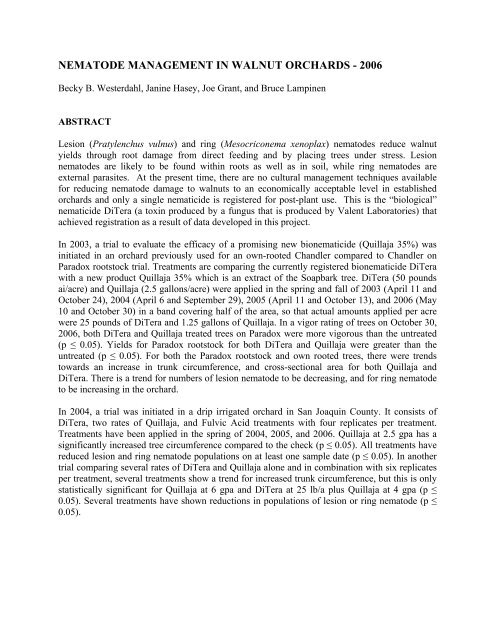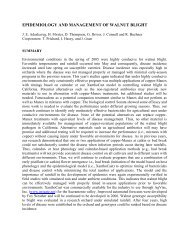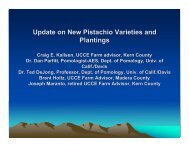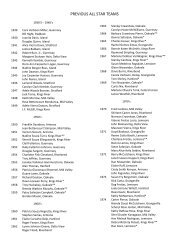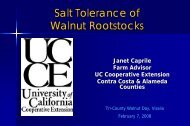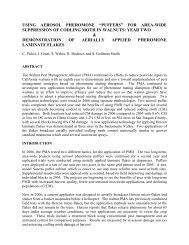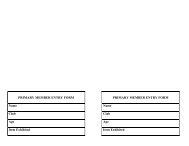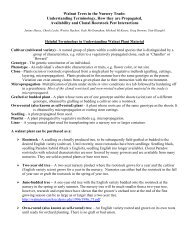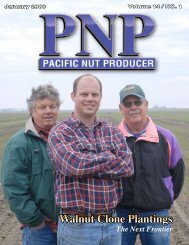nematode management in walnut orchards - Walnut Research Reports
nematode management in walnut orchards - Walnut Research Reports
nematode management in walnut orchards - Walnut Research Reports
Create successful ePaper yourself
Turn your PDF publications into a flip-book with our unique Google optimized e-Paper software.
NEMATODE MANAGEMENT IN WALNUT ORCHARDS - 2006<br />
Becky B. Westerdahl, Jan<strong>in</strong>e Hasey, Joe Grant, and Bruce Lamp<strong>in</strong>en<br />
ABSTRACT<br />
Lesion (Pratylenchus vulnus) and r<strong>in</strong>g (Mesocriconema xenoplax) <strong>nematode</strong>s reduce <strong>walnut</strong><br />
yields through root damage from direct feed<strong>in</strong>g and by plac<strong>in</strong>g trees under stress. Lesion<br />
<strong>nematode</strong>s are likely to be found with<strong>in</strong> roots as well as <strong>in</strong> soil, while r<strong>in</strong>g <strong>nematode</strong>s are<br />
external parasites. At the present time, there are no cultural <strong>management</strong> techniques available<br />
for reduc<strong>in</strong>g <strong>nematode</strong> damage to <strong>walnut</strong>s to an economically acceptable level <strong>in</strong> established<br />
<strong>orchards</strong> and only a s<strong>in</strong>gle nematicide is registered for post-plant use. This is the “biological”<br />
nematicide DiTera (a tox<strong>in</strong> produced by a fungus that is produced by Valent Laboratories) that<br />
achieved registration as a result of data developed <strong>in</strong> this project.<br />
In 2003, a trial to evaluate the efficacy of a promis<strong>in</strong>g new bionematicide (Quillaja 35%) was<br />
<strong>in</strong>itiated <strong>in</strong> an orchard previously used for an own-rooted Chandler compared to Chandler on<br />
Paradox rootstock trial. Treatments are compar<strong>in</strong>g the currently registered bionematicide DiTera<br />
with a new product Quillaja 35% which is an extract of the Soapbark tree. DiTera (50 pounds<br />
ai/acre) and Quillaja (2.5 gallons/acre) were applied <strong>in</strong> the spr<strong>in</strong>g and fall of 2003 (April 11 and<br />
October 24), 2004 (April 6 and September 29), 2005 (April 11 and October 13), and 2006 (May<br />
10 and October 30) <strong>in</strong> a band cover<strong>in</strong>g half of the area, so that actual amounts applied per acre<br />
were 25 pounds of DiTera and 1.25 gallons of Quillaja. In a vigor rat<strong>in</strong>g of trees on October 30,<br />
2006, both DiTera and Quillaja treated trees on Paradox were more vigorous than the untreated<br />
(p ≤ 0.05). Yields for Paradox rootstock for both DiTera and Quillaja were greater than the<br />
untreated (p ≤ 0.05). For both the Paradox rootstock and own rooted trees, there were trends<br />
towards an <strong>in</strong>crease <strong>in</strong> trunk circumference, and cross-sectional area for both Quillaja and<br />
DiTera. There is a trend for numbers of lesion <strong>nematode</strong> to be decreas<strong>in</strong>g, and for r<strong>in</strong>g <strong>nematode</strong><br />
to be <strong>in</strong>creas<strong>in</strong>g <strong>in</strong> the orchard.<br />
In 2004, a trial was <strong>in</strong>itiated <strong>in</strong> a drip irrigated orchard <strong>in</strong> San Joaqu<strong>in</strong> County. It consists of<br />
DiTera, two rates of Quillaja, and Fulvic Acid treatments with four replicates per treatment.<br />
Treatments have been applied <strong>in</strong> the spr<strong>in</strong>g of 2004, 2005, and 2006. Quillaja at 2.5 gpa has a<br />
significantly <strong>in</strong>creased tree circumference compared to the check (p ≤ 0.05). All treatments have<br />
reduced lesion and r<strong>in</strong>g <strong>nematode</strong> populations on at least one sample date (p ≤ 0.05). In another<br />
trial compar<strong>in</strong>g several rates of DiTera and Quillaja alone and <strong>in</strong> comb<strong>in</strong>ation with six replicates<br />
per treatment, several treatments show a trend for <strong>in</strong>creased trunk circumference, but this is only<br />
statistically significant for Quillaja at 6 gpa and DiTera at 25 lb/a plus Quillaja at 4 gpa (p ≤<br />
0.05). Several treatments have shown reductions <strong>in</strong> populations of lesion or r<strong>in</strong>g <strong>nematode</strong> (p ≤<br />
0.05).
OBJECTIVES<br />
1. Optimize sampl<strong>in</strong>g strategies and treatment tim<strong>in</strong>g for lesion and r<strong>in</strong>g <strong>nematode</strong> on <strong>walnut</strong>s<br />
<strong>in</strong> a San Joaqu<strong>in</strong> County Orchard.<br />
2. Evaluate performance of Quillaja 35% and DiTera <strong>in</strong> a Sutter County orchard.<br />
3. Evaluate performance of Quillaja 35%, DiTera, and Fulvic Acid <strong>in</strong> a San Joaqu<strong>in</strong> County<br />
orchard.<br />
4. Evaluate performance of bionematicides <strong>in</strong> a Solano County orchard.<br />
PROCEDURES<br />
Lesion (Pratylenchus vulnus) and r<strong>in</strong>g (Mesocriconema xenoplax) <strong>nematode</strong>s reduce <strong>walnut</strong><br />
yields through root damage from direct feed<strong>in</strong>g and by plac<strong>in</strong>g trees under stress (Lownsbery,<br />
1956 and 1959; Lownsbery et al., 1978). Lesion <strong>nematode</strong>s are likely to be found with<strong>in</strong> roots<br />
as well as <strong>in</strong> soil, while r<strong>in</strong>g <strong>nematode</strong>s are external parasites. At the present time, there are no<br />
cultural <strong>management</strong> techniques available for reduc<strong>in</strong>g <strong>nematode</strong> damage to <strong>walnut</strong>s to an<br />
economically acceptable level <strong>in</strong> established <strong>orchards</strong> and only a s<strong>in</strong>gle nematicide is registered<br />
for post-plant use. This is the “biological” nematicide DiTera (a tox<strong>in</strong> produced by a fungus that<br />
is produced by Valent Laboratories) that achieved registration as a result of data developed <strong>in</strong><br />
this project. Quillaja 35% which is an extract of the Soapbark tree is another promis<strong>in</strong>g<br />
bionematicide. Desert K<strong>in</strong>g is actively pursu<strong>in</strong>g registration of the product with both CA and US<br />
EPA and there is promis<strong>in</strong>g efficacy data on grapes and tomatoes <strong>in</strong> Chile.<br />
1. Optimize sampl<strong>in</strong>g strategies and treatment tim<strong>in</strong>g for lesion and r<strong>in</strong>g <strong>nematode</strong> on <strong>walnut</strong>s<br />
<strong>in</strong> a San Joaqu<strong>in</strong> County Orchard.<br />
A trial with 17 treatments (Table 1) is <strong>in</strong> progress to evaluate whether reduced rates (25 and 12.5<br />
vs 50 pounds/acre) of the bionematicde DiTera will be effective <strong>in</strong> controll<strong>in</strong>g lesion and r<strong>in</strong>g<br />
<strong>nematode</strong>s; to evaluate four rates of Quillaja 35% (6, 4, 2.5, and 1.25 gallons/acre); and to<br />
evaluate the effectiveness of comb<strong>in</strong>ations of DiTera and Quillaja (50 lb/a + 4 gpa, 50 lb/a + 2.5<br />
gpa, 25 lb/a + 4 gpa, 25 lb/a + 2.5 gpa, 12.5 lb/a + 4 gpa, 12.5 lb/a + 2.5 gpa). This is a<br />
randomized complete block trial with six replicates per treatment. Treatments <strong>in</strong>clude an<br />
untreated check and treatment effectiveness is be<strong>in</strong>g evaluated via soil and root sampl<strong>in</strong>g, and<br />
trunk circumference measurements. The 50 lb/acre DiTera treatment was applied either once <strong>in</strong><br />
the spr<strong>in</strong>g of 2004 (DiTera 50) or 2005, (DiTera 0 + 50), or <strong>in</strong> the spr<strong>in</strong>g of both years (DiTera<br />
50 + 50). All of the other treatments were applied <strong>in</strong> the spr<strong>in</strong>g of 2005.<br />
Data is be<strong>in</strong>g analyzed us<strong>in</strong>g analysis of variance followed by <strong>in</strong>dependent contrasts for mean<br />
separation or Fisher’s Protected Least Significant Difference Test.<br />
Nematodes are extracted from soil via elutriation-sugar centrifugation and from roots via mist<br />
chamber extraction. In elutriation-sugar centrifugation, a measured volume of soil is mixed with<br />
a larger volume of water, and poured through a f<strong>in</strong>e mesh sieve which reta<strong>in</strong>s the <strong>nematode</strong>s.
Nematodes washed from the sieve are then mixed with a sugar solution <strong>in</strong> a plastic tube and<br />
centrifuged. Dur<strong>in</strong>g this process, <strong>nematode</strong>s float <strong>in</strong> the sugar solution while any rema<strong>in</strong><strong>in</strong>g soil<br />
particles are pulled to the bottom by the centrifugation. Nozzles at the top of a mist chamber<br />
periodically spray heated water on roots held <strong>in</strong> a mesh basket nested on top of a funnel. The<br />
stem of the funnel resides <strong>in</strong> a test-tube. Nematodes emerge from the roots and are captured at<br />
the bottom of the test-tube while excess water flows over the top of the tube. For both<br />
techniques, extracted <strong>nematode</strong>s are then counted under a microscope.<br />
2. Evaluate performance of Quillaja 35% and DiTera <strong>in</strong> a Sutter County orchard.<br />
The study site is located <strong>in</strong> Sutter County <strong>in</strong> northern California on Holillipah loamy sand. Two<br />
rootstocks, micropropagated ‘Chandler’ on its own-roots and nursery grafted ‘Chandler’ on<br />
seedl<strong>in</strong>g Paradox rootstock were planted <strong>in</strong> 1991 <strong>in</strong> a randomized complete block design spaced<br />
at 25 ft x 25 ft. Trees are irrigated us<strong>in</strong>g microspr<strong>in</strong>klers.<br />
The nematicide trial has 10 <strong>in</strong>dividual tree replicates per treatment (5 Paradox and 5 own-rooted)<br />
for DiTera DF and Quillaja 35% <strong>in</strong> a randomized complete block design. In addition, a new<br />
formulation of DiTera is be<strong>in</strong>g evaluated on 2 Paradox and 5 own-rooted trees. Treatments were<br />
applied <strong>in</strong> 2003 (April 11 and October 24), 2004 (April 6 and September 29), 2005 (April 11 and<br />
October 13), and 2006 (May 10 and October 30) <strong>in</strong> a band cover<strong>in</strong>g half of the area, so that<br />
actual amounts applied per acre were 25 pounds of DiTera and 1.25 gallons of Quillaja.<br />
Treatments are <strong>in</strong>corporated with irrigation. The new formulation of DiTera was not applied to<br />
both rootstocks on all dates due to <strong>in</strong>sufficient product be<strong>in</strong>g available. Data for the new<br />
formulation has not been <strong>in</strong>cluded <strong>in</strong> the figures.<br />
Root and soil samples are taken prior to each treatment date us<strong>in</strong>g a 5 cm bucket auger to a depth<br />
of 60 cm midway between the dripl<strong>in</strong>e and tree trunk <strong>in</strong> the fall and spr<strong>in</strong>g of each year.<br />
Nematodes were extracted from a 400 cm 3 soil sub-sample with a modified semiautomatic<br />
elutriator and sucrose centrifugation technique (Byrd et al., 1976). Data were analyzed us<strong>in</strong>g<br />
analysis of variance followed by <strong>in</strong>dependent contrasts for mean separation or Fisher’s Protected<br />
Least Significant Difference Test.<br />
3. Evaluate performance of Quillaja 35%, DiTera, and Fulvic Acid <strong>in</strong> a San Joaqu<strong>in</strong> County<br />
orchard.<br />
In 2004, a trial was <strong>in</strong>itiated <strong>in</strong> a drip irrigated orchard <strong>in</strong> San Joaqu<strong>in</strong> County. It consists of<br />
DiTera, two rates of Quillaja (2.5 and 4 gpa), and Fulvic Acid treatments with four replicates per<br />
treatment. Treatments have been applied <strong>in</strong> the spr<strong>in</strong>g of 2004, 2005, and 2006. Treatments are<br />
applied through the drip irrigation system. Treatment effectiveness is be<strong>in</strong>g evaluated via soil<br />
and root sampl<strong>in</strong>g, and trunk circumference measurements. Data is be<strong>in</strong>g analyzed us<strong>in</strong>g<br />
analysis of variance followed by <strong>in</strong>dependent contrasts for mean separation.
4. Evaluate performance of bionematicides <strong>in</strong> a Solano County orchard.<br />
In 2006, three trials were <strong>in</strong>itiated <strong>in</strong> an 8-acre block of third leaf <strong>walnut</strong>s at Lester Farms that<br />
has a high population of lesion and r<strong>in</strong>g <strong>nematode</strong>. In the first trial, the large size of the trial area<br />
available is allow<strong>in</strong>g for larger size replicates (30 trees/rep) than <strong>in</strong> our previous trials and<br />
products are be<strong>in</strong>g applied with the grower’s application equipment. The treatments are DiTera<br />
at 25 pounds/acre, Quillaja 35% at 6 gpa and an untreated uncontrol. The trial is be<strong>in</strong>g conducted<br />
<strong>in</strong> a randomized block design with 5 replicates per treatment.<br />
The second trial is be<strong>in</strong>g conducted to test newly available products and consists of ten<br />
treatments, conducted <strong>in</strong> a randomized complete block design with 6 replicates per treatment,<br />
each consist<strong>in</strong>g of a s<strong>in</strong>gle tree. The treatments are an untreated control, two new formulations<br />
of DiTera, an additional new product from Valent, three products from Stoller (ST008, ST007,<br />
and X-Tra Power), Quillaja alone, Quillaja plus Yucca, and DiTera.<br />
The third trial is be<strong>in</strong>g conducted to determ<strong>in</strong>e if frequency or time of the year products are<br />
applied affects efficacy of control. It consists of 16 treatments <strong>in</strong>clud<strong>in</strong>g a control, conducted <strong>in</strong> a<br />
randomized complete block design with 6 replicates per treatment, each consist<strong>in</strong>g of a s<strong>in</strong>gle<br />
tree. DiTera at 25 pounds/acre is be<strong>in</strong>g applied from 1 to 4 times a year, with applications<br />
start<strong>in</strong>g at different times of the year.<br />
RESULTS AND DISCUSSION<br />
1. Optimize sampl<strong>in</strong>g strategies and treatment tim<strong>in</strong>g for lesion and r<strong>in</strong>g <strong>nematode</strong> on <strong>walnut</strong>s<br />
<strong>in</strong> a San Joaqu<strong>in</strong> County Orchard.<br />
In this trial, several treatments show a trend for <strong>in</strong>creased trunk circumference, but this is only<br />
statistically significant for Quillaja at 6 gpa and DiTera at 25 lb/a plus Quillaja at 4 gpa (p ≤<br />
0.05) (Figure 1). Several treatments have shown reductions <strong>in</strong> populations of lesion or r<strong>in</strong>g<br />
<strong>nematode</strong> (p ≤ 0.05) (Table 1).<br />
2. Evaluate performance of Quillaja 35% and DiTera <strong>in</strong> a Sutter County orchard.<br />
In a vigor rat<strong>in</strong>g of trees on October 30, 2006 that was based on the current years growth, both<br />
DiTera and Quillaja treated trees appeared more vigorous than the untreated, although the<br />
untreated seemed to also have improved s<strong>in</strong>ce the 2005 vigor rat<strong>in</strong>g. Statistically, both DiTera<br />
and Quillaja treated trees on Paradox were more vigorous than the untreated (p ≤ 0.05), as were<br />
the DiTera treated trees on own-root (p = 0.08) (Figure 2). Yields for Paradox rootstock for both<br />
DiTera and Quillaja were greater than the untreated (p ≤ 0.05) (Figure 3). Although not<br />
statistically significant, for both rootstocks, there were trends towards an <strong>in</strong>crease of the<br />
difference <strong>in</strong> yield from 2003 to 2006 (Figure 4), <strong>in</strong> trunk circumference (Figure 5), and crosssectional<br />
area (Figure 6) for both Quillaja and DiTera. Quality data were obta<strong>in</strong>ed for this trial,<br />
but were not yet available for presentation <strong>in</strong> this report. In spite of the yield <strong>in</strong>creases and<br />
improvements <strong>in</strong> vigor, over the course of the trial, there have not been significant reductions <strong>in</strong><br />
<strong>nematode</strong> populations. Overall, there is a trend for numbers of lesion <strong>nematode</strong> to be decreas<strong>in</strong>g,
and for r<strong>in</strong>g <strong>nematode</strong> to be <strong>in</strong>creas<strong>in</strong>g <strong>in</strong> the orchard (Table 2). In one case for lesion <strong>nematode</strong>,<br />
and <strong>in</strong> several <strong>in</strong>stances for r<strong>in</strong>g <strong>nematode</strong>, population <strong>in</strong>creases have been observed (p ≤ 0.05).<br />
This could be an <strong>in</strong>dication of the development of a more vigorous root system capable of<br />
support<strong>in</strong>g more <strong>nematode</strong>s.<br />
3. Evaluate performance of Quillaja 35%, DiTera, and Fulvic Acid <strong>in</strong> a San Joaqu<strong>in</strong> County<br />
orchard.<br />
In this trial, Quillaja at 2.5 gpa has a significantly <strong>in</strong>creased tree circumference compared to the<br />
check (p ≤ 0.05) (Figure 7). All treatments have reduced lesion and r<strong>in</strong>g <strong>nematode</strong> populations<br />
on at least one sample date (p ≤ 0.05) (Table 3).<br />
4. Evaluate performance of bionematicides <strong>in</strong> a Solano County orchard.<br />
For all three trials, basel<strong>in</strong>e <strong>nematode</strong> and circumference data have been obta<strong>in</strong>ed and the first set<br />
of treatments had been applied.<br />
LITERATURE CITED<br />
Byrd, D. W., Jr., Barker K. R., Ferris H., Nusbaum C. J., Griff<strong>in</strong> W. E., Small R. H., and Stone<br />
C. A., 1976. Two semi-automatic elutriators for extract<strong>in</strong>g <strong>nematode</strong>s and certa<strong>in</strong> fungi from<br />
soil. Journal of Nematology 8:206-212.<br />
Lownsbery, B. F. 1956. Pratylenchus vulnus, primary cause of the root-lesion disease of <strong>walnut</strong>s.<br />
Phytopathology 46:375-379.<br />
Lownsbery, B. F. 1959. Studies of the <strong>nematode</strong>, Criconemoides xenoplax, on peach. Plant<br />
Disease Reporter. 43:913-917.<br />
Lownsbery, B. F., E. H. Moody, A. Moretto, G. R. Noel, and T. M. Burlando. 1978.<br />
Pathogenicity of Macroposthonia xenoplax to <strong>Walnut</strong>. Journal of Nematology. 10:232-236.<br />
ACKNOWLEDGEMENTS<br />
We are grateful to the grower cooperator Joe Conant of the Whitney Warren Ranch for his<br />
assistance and long-term cooperation, and to Barton Ranch. We are also grateful to Lance<br />
Beem, C<strong>in</strong>dy Anderson, Samuel Metcalf, and Claudia Negron for field and laboratory assistance,<br />
and the California <strong>Walnut</strong> Market<strong>in</strong>g Board, Desert K<strong>in</strong>g, and Valent Laboratories for fund<strong>in</strong>g.
Table 1. Effects on <strong>nematode</strong>s <strong>in</strong> San Joaqu<strong>in</strong> County trial.<br />
Nematodes / liter of soil<br />
Nematodes / gram of root<br />
Lesion Nematode<br />
R<strong>in</strong>g Nematode<br />
Lesion<br />
Different Different Different<br />
than than than<br />
Treatment Sample Date Mean Std. Error Check Mean Std. Error Check Mean Std. Error Check<br />
Check April 2005 2,783 1,078 975 975 8.0 6.5<br />
DiTera 50 2,192 807 0 0 18.8 12.7<br />
DiTera 50 + 50 1,542 466 183 183 1.6 1.1<br />
DiTera 50 + 25 5,667 1,724 1,150 1,007 2.8 1.7<br />
DiTera 0 + 50 6,708 2,450 1,133 795 141.8 137.7 0.10<br />
DiTera 25 4,825 1,127 1,500 1,381 120.9 85.8<br />
DiTera 12.5 4,458 2,017 83 83 203.3 176.0 0.02<br />
DiTera 50 + Quillaja 4 4,233 1,667 583 544 11.4 6.9<br />
DiTera 50 + Quillaja 2.5 3,708 1,580 3,283 2,863 18.0 14.7<br />
DiTera 25 + Quillaja 4 8,733 2,489 83 74 7.8 5.6<br />
DiTera 25 + Quillaja 2.5 3,492 1,031 900 900 44.6 39.1<br />
DiTera 12.5 + Quillaja 4 5,625 1,108 575 575 35.9 29.3<br />
DiTera 12.5 + Quillaja 2.5 8,405 6,334 63 41 0.5 0.5<br />
Quillaja 6 4,667 2,003 0 0 45.0 37.6<br />
Quillaja 4 2,817 703 150 150 129.6 126.1 0.05<br />
Quillaja 2.5 3,875 1,586 750 750 164.8 133.2 0.07<br />
Quillaja 1.25 2,517 478 2,900 1,448 11.2 10.1<br />
Check October 2005 4,208 1,820 317 154 9.5 7.5<br />
DiTera 50 4,783 2,399 208 104 80.3 56.6<br />
DiTera 50 + 50 5,467 2,071 50 50 0.06 12.5 6.8<br />
DiTera 50 + 25 4,850 874 1,000 785 25.4 23.0<br />
DiTera 0 + 50 4,167 345 7,300 5,394 9.0 5.2<br />
DiTera 25 8,075 4,104 950 636 18.1 5.6<br />
DiTera 12.5 4,883 1,299 1,117 878 108.6 47.2<br />
DiTera 50 + Quillaja 4 7,417 1,912 450 450 0.09 12.0 6.4<br />
DiTera 50 + Quillaja 2.5 6,625 1,388 2,500 1,611 14.9 12.0<br />
DiTera 25 + Quillaja 4 4,583 1,358 300 205 80.8 42.8<br />
DiTera 25 + Quillaja 2.5 5,325 3,349 1,650 1,477 3.5 2.4<br />
DiTera 12.5 + Quillaja 4 8,050 2,605 1,183 1,086 74.4 66.9<br />
DiTera 12.5 + Quillaja 2.5 2,333 1,311 0.0005 0 0 0.01 21.9 19.7<br />
Quillaja 6 4,850 1,369 0 0 0.01 94.0 71.5<br />
Quillaja 4 6,600 2,440 800 637 12.6 6.6<br />
Quillaja 2.5 5,433 2,182 4,883 4,060 24.9 19.3<br />
Quillaja 1.25 3,175 407 950 612 229.0 218.3 0.01<br />
Check June 2006 2,950 1,550 1,575 1,055 0.2 0.2<br />
DiTera 50 1,683 741 150 150 0.02 3.9 3.5<br />
DiTera 50 + 50 2,700 1,155 325 296 0.09 11.1 11.1<br />
DiTera 50 + 25 3,275 473 575 465 4.5 2.3<br />
DiTera 0 + 50 2,375 1,288 2,150 1,920 1.6 1.6<br />
DiTera 25 6,075 3,191 525 244 4.4 4.4<br />
DiTera 12.5 3,875 1,516 900 506 4.2 1.5<br />
DiTera 50 + Quillaja 4 1,967 813 2,000 1,361 5.2 3.8<br />
DiTera 50 + Quillaja 2.5 2,350 677 350 350 0.03 2.2 1.6<br />
DiTera 25 + Quillaja 4 1,525 527 0.06 0 0 0.003 1.2 0.8<br />
DiTera 25 + Quillaja 2.5 1,575 636 0.05 1,600 1,323 0.3 0.3<br />
DiTera 12.5 + Quillaja 4 2,200 379 825 686 0.5 0.4<br />
DiTera 12.5 + Quillaja 2.5 3,150 1,273 0 0 0.003 1.7 1.4<br />
Quillaja 6 4,475 1,541 200 200 0.003 12.6 7.8<br />
Quillaja 4 2,650 1,009 1,275 784 15.7 10.2<br />
Quillaja 2.5 1,633 707 475 475 0.03 5.3 3.1<br />
Quillaja 1.25 1,583 509 1,575 1,323 1.4 1.0<br />
Each figure is the mean of 6 replicates.<br />
Figures listed under Different than Check <strong>in</strong>dicate the probability of that Treatment be<strong>in</strong>g different from the Check<br />
on the same sampl<strong>in</strong>g date.
5.0<br />
4.5<br />
4.0<br />
3.5<br />
FIGURE 2. TREE RATING, SUTTER COUNTY TRIAL<br />
PARADOX 0.04 0.03<br />
0.02<br />
Rat<strong>in</strong>g Scale:<br />
0=Dead<br />
1=Very low vigor, dieback 2=Early yellow<strong>in</strong>g<br />
3=No new shoot growth 4=Some new shoot growth<br />
5=Most vigorous<br />
OWN-ROOT<br />
0.08<br />
0.08<br />
0.04<br />
3.0<br />
2.5<br />
2.0<br />
1.5<br />
1.0<br />
0.5<br />
0.0<br />
CHECK<br />
DITERA<br />
QUILLAJA<br />
CHECK<br />
DITERA<br />
QUILLAJA<br />
CHECK<br />
DITERA<br />
QUILLAJA<br />
CHECK<br />
DITERA<br />
QUILLAJA<br />
2005 2006 2005 2006
120<br />
PARADOX<br />
0.02<br />
0.0002 0.005 0.001 0.05<br />
FIGURE 3. YIELD (LB / TREE) IN<br />
SUTTER COUNTY TRIAL<br />
100<br />
0.02<br />
OWN-ROOT<br />
80<br />
0.06<br />
60<br />
40<br />
20<br />
0<br />
CHECK<br />
DITERA<br />
QUILLAJA<br />
CHECK<br />
DITERA<br />
QUILLAJA<br />
CHECK<br />
DITERA<br />
QUILLAJA<br />
CHECK<br />
DITERA<br />
QUILLAJA<br />
CHECK<br />
DITERA<br />
QUILLAJA<br />
CHECK<br />
DITERA<br />
QUILLAJA<br />
CHECK<br />
DITERA<br />
QUILLAJA<br />
CHECK<br />
DITERA<br />
QUILLAJA<br />
CHECK<br />
DITERA<br />
QUILLAJA<br />
CHECK<br />
DITERA<br />
QUILLAJA<br />
2002 2003 2004 2005 2006 2002 2003 2004 2005 2006<br />
80<br />
FIGURE 4. DIFFERENCE IN YIELD BETWEEN 2003 AND 2006 (LB / TREE)<br />
70<br />
60<br />
PARADOX<br />
ERROR BARS<br />
INDICATE 1<br />
STANDARD ERROR<br />
OWN-ROOT<br />
50<br />
40<br />
30<br />
20<br />
10<br />
0<br />
CHECK DITERA QUILLAJA CHECK DITERA QUILLAJA
30<br />
FIGURE 5. DIFFERENCE IN CIRCUMFERENCE BETWEEN 2003 AND 2006 (CM / TREE)<br />
25<br />
20<br />
PARADOX<br />
ERROR BARS<br />
INDICATE 1<br />
STANDARD ERROR<br />
OWN-ROOT<br />
15<br />
10<br />
5<br />
0<br />
CHECK DITERA QUILLAJA CHECK DITERA QUILLAJA<br />
450<br />
FIGURE 6. DIFFERENCE IN CROSS-SECTIONAL AREA BETWEEN 2003 AND 2006 (CM 2 / TREE)<br />
400<br />
350<br />
PARADOX<br />
ERROR BARS<br />
INDICATE 1<br />
STANDARD ERROR<br />
OWN-ROOT<br />
300<br />
250<br />
200<br />
150<br />
100<br />
50<br />
0<br />
CHECK DITERA QUILLAJA CHECK DITERA QUILLAJA
Table 2. Effects on <strong>nematode</strong>s <strong>in</strong> Sutter County Trial.<br />
Paradox<br />
Own-rooted<br />
Different Different Different<br />
Sample Lesion Nematode R<strong>in</strong>g Nematode than Lesion Nematode than R<strong>in</strong>g Nematode than<br />
Treatment Date Mean Std. Error Mean Std. Error Check Mean Std. Error Check Mean Std. Error Check<br />
Check October 2003 3,030 1,288 0 0 4,380 638 10 10<br />
DiTera 3,200 964 0 0 5,740 1,736 100 100<br />
Quillaja 3,820 481 0 0 4,410 1,433 0 0<br />
Check April 2004 1,440 860 40 29 2,560 1,194 110 56<br />
DiTera 1,330 571 540 540 2,020 608 3,270 2,803 0.004<br />
Quillaja 1,320 451 300 300 1,870 818 0 0<br />
Check October 2004 1,130 435 20 20 1,230 293 450 414<br />
DiTera 2,250 990 30 30 2,470 404 3,830 3,109 0.002<br />
Quillaja 1,210 378 420 246 1,580 519 0 0<br />
Check April 2005 870 833 40 24 610 220 300 300<br />
DiTera 1,410 621 0 0 580 237 2,480 2,285 0.04<br />
Quillaja 2,290 1,079 260 260 1,350 539 10 10<br />
Check October 2005 1,470 513 10 10 1,890 529 1,380 926<br />
DiTera 2,060 157 30 30 2,580 1,011 2,340 1,318<br />
Quillaja 2,850 810 540 271 4,970 2,159 0.006 30 30<br />
Check April 2006 1,380 576 1,610 937 1,640 769 590 428<br />
DiTera 2,650 621 980 719 1,300 390 2,560 1,623 0.07<br />
Quillaja 1,310 263 2,020 870 1,680 566 830 756<br />
Check October 2006 470 197 280 150 740 183 470 338<br />
DiTera 320 97 1,340 829 0.05 960 175 290 144<br />
Quillaja 620 238 1,030 515 2,080 527 660 381<br />
Each figure is the mean of 5 replicates.<br />
Figures listed under Different than Check <strong>in</strong>dicate the probability of that Treatment be<strong>in</strong>g different from the Check<br />
on the same sampl<strong>in</strong>g date.<br />
18<br />
FIGURE 7. SAN JOAQUIN COUNTY DRIP IRRIGATION TRIAL,<br />
PERCENT CHANGE IN TREE CIRCUMFERENCE<br />
b<br />
16<br />
14<br />
12<br />
10<br />
8<br />
APRIL 2004 TO<br />
APRIL 2005<br />
APRIL 2004 TO<br />
OCTOBER 2005<br />
b<br />
a a ab ab<br />
APRIL 2004 TO<br />
JUNE 2006<br />
a<br />
a<br />
a<br />
a<br />
a<br />
APRIL 2004 TO<br />
OCTOBER 2006<br />
a<br />
a<br />
a<br />
ab<br />
b<br />
6<br />
ab<br />
a<br />
a<br />
ab<br />
4<br />
2<br />
0<br />
CHECK<br />
DITERA<br />
FULVICACID<br />
QUILLAJA2.5<br />
QUILLAJA4<br />
CHECK<br />
DITERA<br />
FULVICACID<br />
QUILLAJA2.5<br />
QUILLAJA4<br />
CHECK<br />
DITERA<br />
FULVICACID<br />
QUILLAJA2.5<br />
QUILLAJA4<br />
CHECK<br />
DITERA<br />
FULVICACID<br />
QUILLAJA2.5<br />
QUILLAJA4
Table 3. Effects on <strong>nematode</strong> populations <strong>in</strong> San Joaqu<strong>in</strong> County drip Irrigation trial.<br />
Nematodes / liter of soil<br />
Lesion Nematode R<strong>in</strong>g Nematode P<strong>in</strong> Nematode<br />
Different Different Different<br />
than than than<br />
Treatment Sample Date Std. Error Check Std. Error Check Std. Error Check<br />
Check April 2004 3,525 444 1,088 480 0 0<br />
DiTera 1,625 566 638 638 338 338<br />
Fulvic Acid 5,400 3,123 1,575 589 1,425 1,425<br />
Quillaja 2.5 2,863 1,657 63 38 525 525<br />
Quillaja 4 4,613 2,087 825 375 750 750<br />
Check October 2004 4,538 1,386 5,963 2,479 0 0<br />
DiTera 3,513 2,374 300 300 0.0001 188 188<br />
Fulvic Acid 3,738 1,939 4,013 2,258 150 150<br />
Quillaja 2.5 3,725 1,860 250 218 0.0001 38 38<br />
Quillaja 4 2,213 585 1,950 914 0.005 563 359<br />
Check April 2005 4,813 1,306 4,163 1,593 0 0<br />
DiTera 4,213 2,533 1,850 907 0.1 0 0<br />
Fulvic Acid 1,563 719 625 338 0.01 1,125 1,125<br />
Quillaja 2.5 3,450 1,458 1,575 756 0.07 525 525<br />
Quillaja 4 1,938 671 1,788 719 0.09 1,388 895<br />
Check October 2005 9,325 6,235 825 309 0 0<br />
DiTera 4,725 2,386 0.1 3,175 1,565 0.09 825 825<br />
Fulvic Acid 2,325 1,158 0.02 6,900 2,197 0.0001 3,000 3,000 0.01<br />
Quillaja 2.5 4,988 2,518 0.1 3,113 1,366 3,750 3,651 0.002<br />
Quillaja 4 2,813 1,696 0.02 2,963 338 1,650 581<br />
Check June 2006 4,675 595 1,113 572 0 0<br />
DiTera 2,900 788 488 215 1,163 677<br />
Fulvic Acid 7,225 4,353 1,238 901 588 555<br />
Quillaja 2.5 6,113 2,246 925 561 425 425<br />
Quillaja 4 6,513 4,754 850 87 150 150<br />
Check October 2006 2,350 826 588 455 25 25<br />
DiTera 2,325 959 1,463 849 1,913 1,310<br />
Fulvic Acid 613 339 513 171 1,013 1,013<br />
Quillaja 2.5 1,763 283 1,313 439 1,538 854<br />
Quillaja 4 4,575 1,005 375 144 1,275 998<br />
Each figure is the mean of 4 replicates.<br />
Figures listed under Different than Check <strong>in</strong>dicate the probability of that Treatment be<strong>in</strong>g different from the Check<br />
on the same sampl<strong>in</strong>g date.


